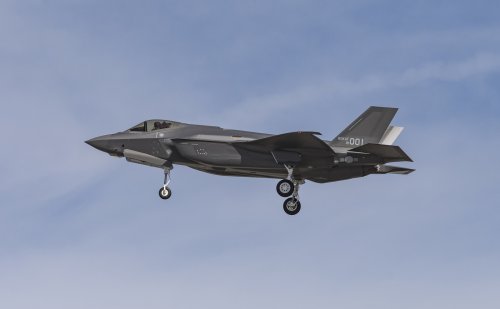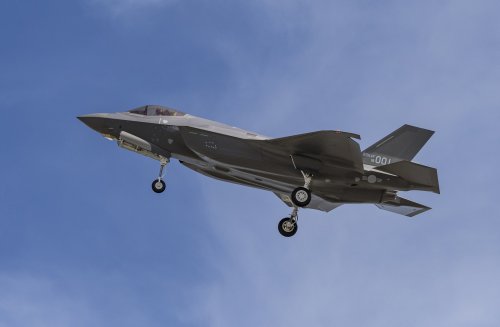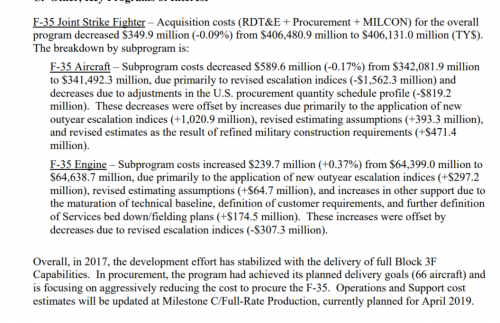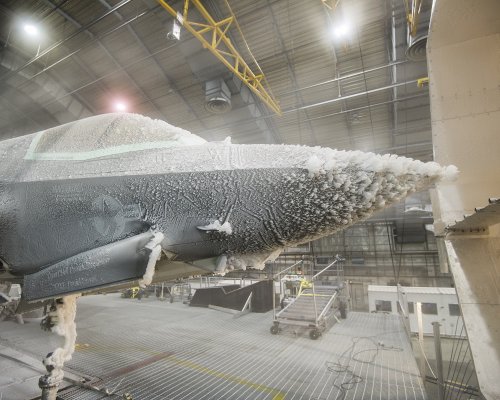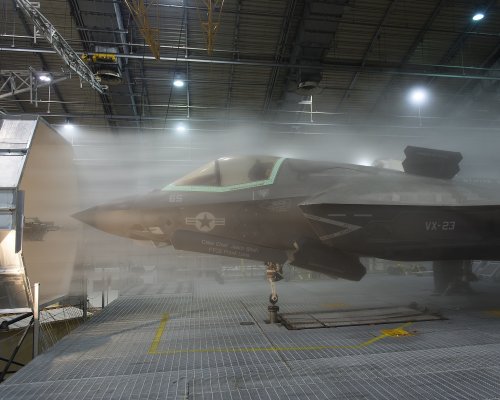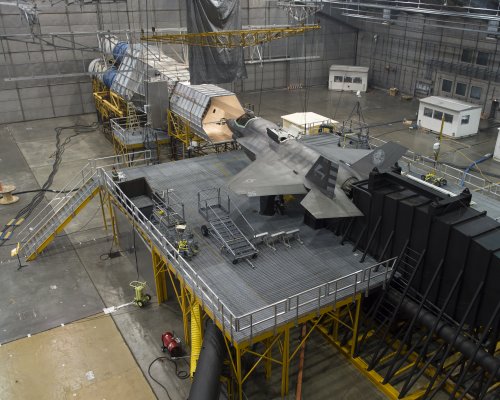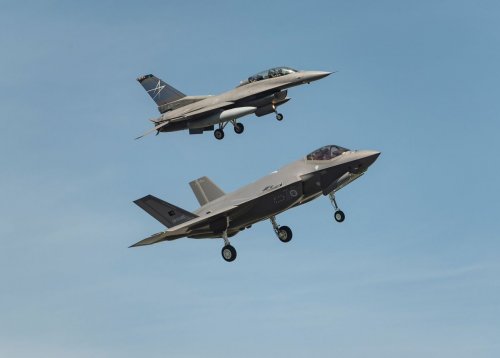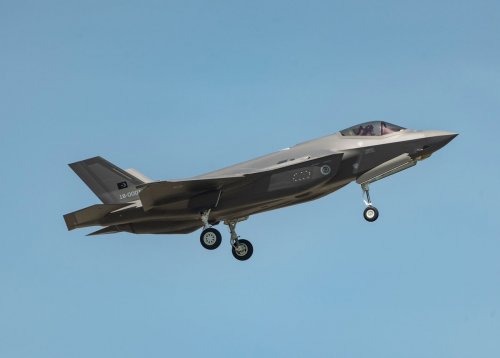You are using an out of date browser. It may not display this or other websites correctly.
You should upgrade or use an alternative browser.
You should upgrade or use an alternative browser.
Lockheed Martin F-35 Lightning II Joint Strike Fighter (JSF)
- Thread starter Triton
- Start date
-
- Tags
- f-35 lockheed martin stealth usa
seruriermarshal
ACCESS: Top Secret
- Joined
- 4 May 2008
- Messages
- 1,177
- Reaction score
- 533
- Joined
- 21 April 2009
- Messages
- 13,148
- Reaction score
- 5,988
https://www.defensenews.com/smr/kadena-air-base/2018/03/27/how-is-the-f-35-improving-its-dogfighting-skills-in-japan/
Capt. Brock McGehee, a pilot from Kadena’s 44th Fighter Squadron who has been flying F-15s for two years, characterized the F-35 as an “extremely capable” air-to-air fighter, during a February interview with Defense News.
“It’s just kind of scary a little bit to fly around in the dark with an invisible airplane that’s around you somewhere,” he said. “Those guys are very good pilots, their situational awareness is very high and they do a good job of keeping us in the loop of where they are when they’re on the same team as us.”
McGehee compared the F-35 to its fifth-generation brother, the F-22 Raptor. Both are stealth aircraft, making them very difficult to detect at long distances. But in close combat, an F-15 will engage an F-22 and F-35 very differently, he said. He declined to discuss specifics that could reveal tactics, techniques and procedures and provide an adversary with hints about how to best either aircraft.
Airplane
ACCESS: Secret
- Joined
- 3 October 2015
- Messages
- 434
- Reaction score
- 45
Air Force Risks Losing Third of F-35s If Upkeep Costs Aren't Cut
http://www.msn.com/en-us/money/companies/air-force-risks-losing-third-of-f-35s-if-upkeep-costs-arent-cut/ar-BBKO1GS?li=BBmkt5R&ocid=ientp
http://www.msn.com/en-us/money/companies/air-force-risks-losing-third-of-f-35s-if-upkeep-costs-arent-cut/ar-BBKO1GS?li=BBmkt5R&ocid=ientp
- Joined
- 9 November 2008
- Messages
- 1,070
- Reaction score
- 136
Ah... the obligatory (likely from the CBO) "the sky is falling" report even though they have known about the lifetime $1.x Trillion cost. Funny how the latest SAR puts the F-35's CPFH only 14% higher than the F-16 yet they might need to cancel a third of them?
bring_it_on
I really should change my personal text
- Joined
- 4 July 2013
- Messages
- 3,123
- Reaction score
- 2,235
What the SAR does is reasonable but it is not the complete picture. The program has set an aggressive goal of reducing O&S cost by 30% so look at these articles in that context just as the procurement costs in the early LRIP was reported on extensively (how high it was etc). The program is also negotiating through software and hardware baseline issues with Lockheed and other suppliers so they are likely also applying some pressure. But it is only reasonable for the USAF to draw up various contingencies and game out scenarios where they have a range of fleet sizes that future leadership will have to consider. I still remember there were reports a few years ago that they were going to buy 70-100 F-15's or F-16's (even F-18s). I don't doubt that those were legitimate but suspect those were always unlikely to be acted upon.
- Joined
- 9 November 2008
- Messages
- 1,070
- Reaction score
- 136
The only what to gauge year-over-year drops in CPFH is to look at the inter-agency Reimbursable-CPFH.
http://comptroller.defense.gov/Financial-Management/Reports/rates2018/
Looking at FY2016/17/18 timeline, the R-CPFH went $28k, $21k, $17k.
For comparison, the R-CPFH for other aircraft are below:
F-15C - $20.7k
F-15D - $21.1k
F-15E - $16.6k
F-16C - $7.6k
F-22 - $35.2k
The R-CPFH is the "Brown" square below.

http://comptroller.defense.gov/Financial-Management/Reports/rates2018/
Looking at FY2016/17/18 timeline, the R-CPFH went $28k, $21k, $17k.
For comparison, the R-CPFH for other aircraft are below:
F-15C - $20.7k
F-15D - $21.1k
F-15E - $16.6k
F-16C - $7.6k
F-22 - $35.2k
The R-CPFH is the "Brown" square below.

NeilChapman
Interested 3rd party
- Joined
- 14 December 2015
- Messages
- 1,282
- Reaction score
- 477
bring_it_on said:What the SAR does is reasonable but it is not the complete picture. The program has set an aggressive goal of reducing O&S cost by 30% so look at these articles in that context just as the procurement costs in the early LRIP was reported on extensively (how high it was etc). The program is also negotiating through software and hardware baseline issues with Lockheed and other suppliers so they are likely also applying some pressure. But it is only reasonable for the USAF to draw up various contingencies and game out scenarios where they have a range of fleet sizes that future leadership will have to consider. I still remember there were reports a few years ago that they were going to buy 70-100 F-15's or F-16's (even F-18s). I don't doubt that those were legitimate but suspect those were always unlikely to be acted upon.
If they can get ALIS working (correctly) then perhaps 30% is not unreasonable.
bring_it_on
I really should change my personal text
- Joined
- 4 July 2013
- Messages
- 3,123
- Reaction score
- 2,235
I don't think it is a matter of "IF", but a matter of "WHEN". It is behind, and as the previous PEO said, had ALIS been a separate program it would have been an ACAT-1 program in its own right. In other words, a PHM system for an advanced fighter aircraft enterprise is complicated and is taking them longer than planned. I'd give it 2-3 more years for them to fully get it working and then add capability to rectify some of the deficiencies that that they need to close out before adding yet another cycle of enhancements via block 4.
That said, the focus has very much shifted from increasing buy rate and reducing unit cost to sustaining it affordably and the solution is not merely technical (as in sorting out ALIS) but also policy related and involves multiple stakeholders within he DOD for it to work. It is good that the Program EO, Ellen Lord and the service chiefs are all openly talking about the need to reduce this as it will require this focus at the highest level for them to get to that 30% target that was noted by the PEO in his most recent Congressional testimony.
Dr. Rebeca Grant discuses this issue with Lt. Gen Bruce Litchfield, Lt. Gen. Do Wtekam, and Maj Gen. David Gillett in the Air Force Association's Airman For Life Podcast if anyone is interested.
That said, the focus has very much shifted from increasing buy rate and reducing unit cost to sustaining it affordably and the solution is not merely technical (as in sorting out ALIS) but also policy related and involves multiple stakeholders within he DOD for it to work. It is good that the Program EO, Ellen Lord and the service chiefs are all openly talking about the need to reduce this as it will require this focus at the highest level for them to get to that 30% target that was noted by the PEO in his most recent Congressional testimony.
Dr. Rebeca Grant discuses this issue with Lt. Gen Bruce Litchfield, Lt. Gen. Do Wtekam, and Maj Gen. David Gillett in the Air Force Association's Airman For Life Podcast if anyone is interested.
Attachments
Article from Jerusalem Post
http://www.jpost.com/Middle-East/Report-Israeli-stealth-fighters-fly-over-Iran-547421
"Two Israeli F-35 fighter jets entered Iranian airspace over the past month, Kuwaiti newspaper Al-Jarida reported on Thursday. The act is a signal of heightened regional tensions, especially in light of recent Israeli military attacks in Syria, including against Iranian bases in the country.
Sources quoted in Al-Jarida stated that two stealth fighters flew over Syrian and Iraqi airspace to reach Iran, and even targeted locations in the Iranian cities Bandar Abbas, Esfahan and Shiraz. "
http://www.jpost.com/Middle-East/Report-Israeli-stealth-fighters-fly-over-Iran-547421
"Two Israeli F-35 fighter jets entered Iranian airspace over the past month, Kuwaiti newspaper Al-Jarida reported on Thursday. The act is a signal of heightened regional tensions, especially in light of recent Israeli military attacks in Syria, including against Iranian bases in the country.
Sources quoted in Al-Jarida stated that two stealth fighters flew over Syrian and Iraqi airspace to reach Iran, and even targeted locations in the Iranian cities Bandar Abbas, Esfahan and Shiraz. "
bring_it_on
I really should change my personal text
- Joined
- 4 July 2013
- Messages
- 3,123
- Reaction score
- 2,235
https://www.youtube.com/watch?v=SlsPp4I2POU
- Joined
- 9 November 2008
- Messages
- 1,070
- Reaction score
- 136

The Commanding Officer of Marine Fighter Attack Squadron 122 (VMFA-122), Lt. Col. John P. Price, conducts a pre-flight check of aircraft in preperation of VMFA-122’s first flight operations in an F-35B Lightning II on Marine Corps Air Station (MCAS) Yuma, Ariz., March 29, 2018. VMFA-122 is conducting the flight operations for the first time as an F-35 squadron. (U.S. Marine Corps photo by Sgt. Allison Lotz)
I guess that's one place that you can safely put color graphics on a VLO airframe B)
https://theaviationist.com/2018/04/02/vmfa-122-conducted-first-flight-with-the-f-35b-lightning-ii-at-marine-corps-air-station-yuma/
- Joined
- 21 April 2009
- Messages
- 13,148
- Reaction score
- 5,988
https://breakingdefense.com/2018/04/aussie-f-35a-drives-historic-shift-to-usaf-focus-from-usn/
RAAF BASE WILLIAMTOWN: The unique capabilities of the 72 F-35As Australia will buy are driving the close US ally to rethink and build new infrastructure to protect the aircraft’s highly classified stealth capabilities, as well as its data, Air Commodore Michael Kitcher said during a visit here.
The Royal Australian Air Force Air Combat Group Commander is guiding his country’s fundamental transition from a legacy fleet of fourth generation Hornets to the fifth generation F-35A fleet. And that transition is taking place within an even broader shift for the Aussies as they’ve added C-17s, KC-30As and Wedgetails over the past few years. The pace of transformation is rather breathtaking: if you thought that the five past years brought quite a change, wait to see what the next three years are about to bring about!
The challenges to transition and stand up two F-35A squadrons here over three years are enormous. That’s why Kitcher emphasizes a realistic and focused approach. “We do not have to connect every player at all times with each other, but remain mission-oriented,” he reminds us.
https://insidedefense.com/daily-news/lord-pentagon-shakes-f-35-management-structure?platform=hootsuite
The Pentagon will establish service-run program offices for the Joint Strike Fighter -- a departure from the current construct, which centralizes all F-35 program management within one office that reports to the Office of the Secretary of Defense, Inside Defense has learned. The reorganization will allow the military departments to have more direct ownership of their own F-35 program and leverage organic capabilities, processes and infrastructure, according to a March 27 letter Pentagon acquisition executive Ellen Lord sent to...
bring_it_on
I really should change my personal text
- Joined
- 4 July 2013
- Messages
- 3,123
- Reaction score
- 2,235
bring_it_on
I really should change my personal text
- Joined
- 4 July 2013
- Messages
- 3,123
- Reaction score
- 2,235
From the FY18 (December,2017) DOD Comprehensive SAR
F-35 Joint Strike Fighter – Acquisition costs (RDT&E + Procurement + MILCON) for the overall
program decreased $349.9 million (-0.09%) from $406,480.9 million to $406,131.0 million (TY$).
The breakdown by subprogram is:
F-35 Aircraft – Subprogram costs decreased $589.6 million (-0.17%) from $342,081.9 million
to $341,492.3 million, due primarily to revised escalation indices (-$1,562.3 million) and
decreases due to adjustments in the U.S. procurement quantity schedule profile (-$819.2
million). These decreases were offset by increases due primarily to the application of new
outyear escalation indices (+1,020.9 million), revised estimating assumptions (+393.3 million),
and revised estimates as the result of refined military construction requirements (+$471.4
million).
F-35 Engine – Subprogram costs increased $239.7 million (+0.37%) from $64,399.0 million to
$64,638.7 million, due primarily to the application of new outyear escalation indices (+$297.2
million), revised estimating assumptions (+$64.7 million), and increases in other support due to
the maturation of technical baseline, definition of customer requirements, and further definition
of Services bed down/fielding plans (+$174.5 million). These increases were offset by
decreases due to revised escalation indices (-$307.3 million).
Overall, in 2017, the development effort has stabilized with the delivery of full Block 3F
Capabilities. In procurement, the program had achieved its planned delivery goals (66 aircraft) and
is focusing on aggressively reducing the cost to procure the F-35. Operations and Support cost
estimates will be updated at Milestone C/Full-Rate Production, currently planned for April 2019.
Attachments
http://aviationweek.com/defense/f-35-completes-flight-trials-now-final-test?NL=AW-05&Issue=AW-05_20180413_AW-05_19&sfvc4enews=42&cl=article_3&utm_rid=CPEN1000001204619&utm_campaign=14452&utm_medium=email&elq2=3d3aca9a9a5b44baaa1032fbcc9d2dd6

For Lockheed Martin test pilot Billie Flynn, the most surreal experience working on the F-35 was taking the aircraft into the climactic chamber to see how it fared in the most extreme environments.
“Freezing it down to 40 below and baking it up to 120 degrees, firing ice at it through these one-of-a kind ice-maker jet rockets, and all the while hovering an F-35 inside a hangar with the doors closed,” Flynn said, describing the climactic tests.
- Joined
- 3 June 2011
- Messages
- 17,303
- Reaction score
- 8,997
Article from Sea Air Space: http://www.asdnews.com/news/defense/2018/04/12/280-f35s-delivered-thousands-more-works-we-own-fight-says-admiral
Interesting tidbit:
“Our Israeli teammates declared IOC [initial operational capability] last December,” Winter said. “They’re flying real missions and operating their F-35 air system in country as we speak.”
Interesting tidbit:
“Our Israeli teammates declared IOC [initial operational capability] last December,” Winter said. “They’re flying real missions and operating their F-35 air system in country as we speak.”
- Joined
- 3 September 2006
- Messages
- 1,387
- Reaction score
- 1,210
http://www.iaf.org.il/4467-49794-HE/IAF.aspxfredymac said:Interesting tidbit:
“Our Israeli teammates declared IOC [initial operational capability] last December,” Winter said. “They’re flying real missions and operating their F-35 air system in country as we speak.”
The Israeli Air Force has declared its first F-35i Adir squadron operational on Dec. 6, 2017.
It has been used to deal with hostile situations from Syria and Levanon regularly since. Interestingly, so far more in SIGINT/ISR role rather than combat.
- Joined
- 6 September 2006
- Messages
- 4,310
- Reaction score
- 7,451
The RAF's 617 Squadron has been officially re-formed today in Washington DC as it works up on the F-35B.
https://www.flightglobal.com/news/articles/uk-re-forms-617-sqn-for-f-35b-era-447809/
https://www.flightglobal.com/news/articles/uk-re-forms-617-sqn-for-f-35b-era-447809/
- Joined
- 21 January 2015
- Messages
- 10,653
- Reaction score
- 12,255
Iconic Dambusters Squadron Makes Historic Transition
https://www.forces.net/news/iconic-dambusters-squadron-makes-historic-transition
617 Squadron of the Royal Air Force has been formally stood up as the RAF's first F35B Lightning II squadron.
The announcement was made during a special event in Washington DC, part of the celebrations for the Royal Air Force in its centenary year.
In the heart of the US capital, history was made as 617 Squadron formally stood up as an operational squadron, the first F35 squadron in the Royal Air Force.
https://www.forces.net/news/iconic-dambusters-squadron-makes-historic-transition
- Joined
- 6 September 2006
- Messages
- 4,310
- Reaction score
- 7,451
The US Assistant secretary of state for European and Eurasian Affairs Wess Mitchell has threatened to use the Lockheed Martin F-35 programme as a retaliatory tool against Turkey if it goes ahead with its planned S-400 Triumpf purchase.
https://www.flightglobal.com/news/articles/us-diplomat-threatens-turkeys-f-35-role-in-s-400-sp-447859/
https://www.flightglobal.com/news/articles/us-diplomat-threatens-turkeys-f-35-role-in-s-400-sp-447859/
- Joined
- 3 June 2011
- Messages
- 17,303
- Reaction score
- 8,997
Hood said:The US Assistant secretary of state for European and Eurasian Affairs Wess Mitchell has threatened to use the Lockheed Martin F-35 programme as a retaliatory tool against Turkey if it goes ahead with its planned S-400 Triumpf purchase.
https://www.flightglobal.com/news/articles/us-diplomat-threatens-turkeys-f-35-role-in-s-400-sp-447859/
Good. If Turkey is going to get in bed with Russia we'd be insane to keep them in the program anyway.
NeilChapman
Interested 3rd party
- Joined
- 14 December 2015
- Messages
- 1,282
- Reaction score
- 477
sferrin said:Hood said:The US Assistant secretary of state for European and Eurasian Affairs Wess Mitchell has threatened to use the Lockheed Martin F-35 programme as a retaliatory tool against Turkey if it goes ahead with its planned S-400 Triumpf purchase.
https://www.flightglobal.com/news/articles/us-diplomat-threatens-turkeys-f-35-role-in-s-400-sp-447859/
Good. If Turkey is going to get in bed with Russia we'd be insane to keep them in the program anyway.
+ 1
And perhaps that production can be acquired by the US to increase delivery rates to the USAF. The US could find other countries that would be more than willing to accept the maintenance facilities Turkey was to host. Allowing TAI to participate in center fuselage production was wishful thinking. Turkey was an up and coming country 25 years ago. It's population has become much more radicalized in the last 20.
I was working with a group of Turkish policemen on September 11, 2001. I could see it in the group I was working with. The majority were embarrassed by the rhetoric of the more radical guys. But they weren't willing to confront them. Scary stuff.
aero-engineer
ACCESS: Restricted
- Joined
- 9 July 2007
- Messages
- 49
- Reaction score
- 2
I think there may be a misconception about Turkey's F-35 participation. They are heavily embedded into the F-35 program. They produce center fuselages for the entire program, including USAF aircraft.
"This is the first F-35 center fuselage manufactured by TAI as an international manufacturing partner to Northrop Grumman. The center fuselage will be installed into a U. S. Air Force aircraft at Lockheed Martin's facilities in Fort Worth, Texas..... Once the program reaches full rate production, TAI will support F-35 final assembly lines in the United States and Italy by shipping one center fuselage every 10 days. TAI's center fuselages will be integrated into the Turkish F-35 aircraft as well as other participating nations' aircraft."
"In addition to building center fuselages as a Northrop Grumman subcontractor, TAI is the single source for center fuselage metallic assemblies for F-35A, selected composite components for all F-35 variants, and is one of two sources for composite air inlet ducts for F-35A, and air-to-ground alternate mission pylons for all F-35 variants."
https://globenewswire.com/news-release/2013/12/12/596570/10061351/en/TAI-Delivers-First-Center-Fuselage-to-Northrop-Grumman-Under-JSF-F-35-Program.html
"This is the first F-35 center fuselage manufactured by TAI as an international manufacturing partner to Northrop Grumman. The center fuselage will be installed into a U. S. Air Force aircraft at Lockheed Martin's facilities in Fort Worth, Texas..... Once the program reaches full rate production, TAI will support F-35 final assembly lines in the United States and Italy by shipping one center fuselage every 10 days. TAI's center fuselages will be integrated into the Turkish F-35 aircraft as well as other participating nations' aircraft."
"In addition to building center fuselages as a Northrop Grumman subcontractor, TAI is the single source for center fuselage metallic assemblies for F-35A, selected composite components for all F-35 variants, and is one of two sources for composite air inlet ducts for F-35A, and air-to-ground alternate mission pylons for all F-35 variants."
https://globenewswire.com/news-release/2013/12/12/596570/10061351/en/TAI-Delivers-First-Center-Fuselage-to-Northrop-Grumman-Under-JSF-F-35-Program.html
bring_it_on
I really should change my personal text
- Joined
- 4 July 2013
- Messages
- 3,123
- Reaction score
- 2,235
That is the current production arrangement which divided production to additional program partners. The primary central fuselage builder is Northrop Grumman and if Turkey is kicked out of the program, it and its other partners would have to carry any production volume. Although there may be a lead time for them in boosting production, I'm sure they won't mind the extra work. Having said that, even though I doubt that Turkey will be kicked out given that the DOD is likely to take a long term view on this and not just a short term one focusing on Erdogan. If it were up to me, I would have put a hold on the sale, the moment they confirmed the S-400 purchase.
- Joined
- 3 June 2011
- Messages
- 17,303
- Reaction score
- 8,997
bring_it_on said:If it were up to me, I would have put a hold on the sale, the moment they confirmed the S-400 purchase.
This.
- Joined
- 21 April 2009
- Messages
- 13,148
- Reaction score
- 5,988
https://www.themaven.net/warriormaven/air/f-35-drone-like-sensors-send-target-data-to-aircraft-carriers-land-weapons-hq70Sr_UNEq5WBurMd4w2w/
The Pentagon’s F-35 has conducted test attack missions in tandem with other aircraft, surface ships and ground weapons as part of its maturation as both a multi-role fighter and aerial “node” or sensor system able to acquire and relay target information.
Alongside its widely discussed “attack” weapons and technologies, including a 25mm cannon along with air-to-air and air-to-ground weapons, the F-35 is increasingly being developed as a platform able to perform “drone-like” targeting and surveillance missions.
Referring to the F-35s long-range sensors and ISR capabilities, Pentagon officials have told Warrior Maven that the aircraft has cued land weapons and surface ships in recent exercises.
- Joined
- 6 September 2006
- Messages
- 4,310
- Reaction score
- 7,451
A bi-partisan group of US senators introduced a bill on 26 April to prevent the transfer of the Lockheed Martin F-35A to Turkey and their role as an F-35 maintenance depot.
https://www.flightglobal.com/news/articles/us-senators-introduce-bill-to-block-f-35-delivery-to-448084/
https://www.flightglobal.com/news/articles/us-senators-introduce-bill-to-block-f-35-delivery-to-448084/
bring_it_on
I really should change my personal text
- Joined
- 4 July 2013
- Messages
- 3,123
- Reaction score
- 2,235
- Joined
- 9 November 2008
- Messages
- 1,070
- Reaction score
- 136
More at the JumpLockheed resumes F-35 jet deliveries to Pentagon
WASHINGTON (Reuters) - The U.S. Department of Defense resumed accepting F-35 jet deliveries from Lockheed Martin Corp (LMT.N) last week after reaching an agreement on covering the costs to fix a production error, the Pentagon told Reuters on Monday.
Terms of the agreement were not disclosed. The cost of the fix was $119 million, people familiar with the situation had previously told Reuters.
...
The majority of aircraft will be repaired within two years, the statement said.
https://www.reuters.com/article/us-lockheed-f35-exclusive/lockheed-resumes-f-35-jet-deliveries-to-pentagon-idUSKBN1I827Q
The timeline of two years supports my original theory that the holdup was all about "when" the repairs have to happen rather than "who" will pay for it. It looks like LM will fix them or pay the USAF to fix them when the F-35s are in for pre-scheduled depot maintenance. The two-year number also looks like it will coincide with the Block 3F/concurrency updates that are already scheduled in the budget docs.
seruriermarshal
ACCESS: Top Secret
- Joined
- 4 May 2008
- Messages
- 1,177
- Reaction score
- 533
Turkish AirForce F-35A (18-0001, c/n AT-1) made its 1st flight from NAS JRB Fort Worth
Attachments
- Joined
- 3 June 2006
- Messages
- 2,832
- Reaction score
- 2,503
Please notice the new roundel of the Turkish Air Force; it's also featured on TAI TFX concept pictures. Like with the US flag on the right uniform sleeve, the Turkish flag on the fin and new roundel on the starboard side are both reversed.
Similar threads
-
Canada Future fighter capability project (ex-Next Generation Fighter Capability)
- Started by aam641
- Replies: 210
-
-
New Canadian Prime Minister committed to withdrawing from F-35 program
- Started by Triton
- Replies: 53
-
-
Lockheed Martin F-16 Fighting Falcon Developments
- Started by seruriermarshal
- Replies: 463

